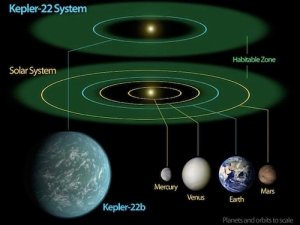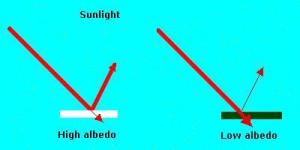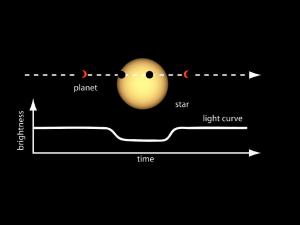Introduction
Since the beginning of human space exploration, mankind has been expanding its reach further and further across the universe. Other star systems and planets that were not even known to exist just a few decades ago are now actively being observed and studied. While our current technologies do not generally allow us to send spacecraft (especially if there are humans onboard) too much further than around our own solar system, innovations in other fields have allowed scientists to study extremely distant star systems and compare them to ours. More and more powerful telescopes are always being created, and at this point we have found planets orbiting stars over 20,000 light years away. A planet found orbiting a star other than the Sun is called an exoplanet, and even though no exoplanet is near enough to Earth to been seen with the naked eye, these mysterious cousins of ours can mimic conditions in our solar system very closely. We would search for life in our solar system, but unfortunately no planets orbiting the Sun, other than Earth, seem too likely to be home to any life. As a result, exoplanets are sometimes thought of as the key to finding extraterrestrial life in our universe. Because the nebula theory describes how all solar systems are born, the existence of a planet as habitable as our Earth is perfectly plausible, even in an extraordinarily far-off star system. So, when scientists are scanning the sky for exoplanets, they generally try to limit their search of the cosmos to stars similar to our a sun, a G-star on the main sequence.
One of the most habitable exoplanets ever discovered, Kepler-22b, falls directly into this category. The star it orbits, Kepler-22, is a G5 star that lies approximately 620 light years away from us, in the Cygnus constellation. Kepler-22b was confirmed to exist on October 1st, 2011, after its 4th transit was observed by the Kepler space telescope. The transit method used to discover this exoplanet is also one of the more commonly used techniques in exoplanet detection. This method works when the Kepler space telescope detects a drop in the luminosity of a star for a short period of time. The drop in luminosity can be explained by the fact that a planet orbiting the star may have come around and temporarily come in between the star and the Earth, blocking some of the star’s emitted light. If viewed at the proper inclination (which is not always possible when observing distant stars, and therefore makes this technique only occasionally optional), transits of this type can prove the existence of orbiting planets. However, it generally takes three observed transits to convince astronomers that an exoplanet does, in fact, exist. Kepler-22 is actually very similar to the Sun, which only adds to scientific interest in this star system. Its luminosity is about 0.8 that of our Sun, its radius is 0.979 Solar radii, and its average temperature lies at around 5500K, making it only about 200K cooler than the Sun. Kepler-22b appears to be in the closer in fifth or so of its star’s habitable zone, so it is expected that the planet will slowly but surely become uninhabitable as the habitable zone moves outward. Regardless, the planet probably has many hundreds of millions or even billions of years until it is no longer habitable. Because of this and all of its host star’s similarities to our Sun, Kepler-22b gives us a better chance of discovering extraterrestrial biology than any other exoplanet discovered to date.
Mathematical Evidence for physical conditions of Kepler-22b
When researching an exoplanet to decide whether or not it may have conditions fit for life, there are a few things to consider. In order for life to exist, there must be a liquid medium in which different molecules can interact with each other (water is usually considered the most likely liquid medium to give rise to life as it is liquid for a large range of warm temperatures), and for a liquid medium to exist on a planet, a planet must be in its star’s habitable zone. To determine whether or not a planet is in its star’s habitable zone, we use two equations to determine the inner and outer boundaries of the habitable zone:
, where L/Lsun is the luminosity of the star in solar luminosities. For Kepler-22, L would be set equal to 0.75 as it is about 75% as luminous as the Sun. After plugging a few numbers in, we learn that the inner limit of the habitable zone for Kepler-22 lies 0.82 AU from the star, and the outer limit lies 1.21 AU from the star. This means that the range of the habitable zone around Kepler-22 is 0.39 AU. Since Kepler-22b lies at 0.85 AU from its star, it is in well within its habitable zone, although closer to the inner limit. Since stars brighten with age, the habitable zone will continue to expand and move outward as time goes on, and eventually Kepler-22b will no longer be encompassed in its star’s habitable zone.
One of the other large determinants over whether or not we consider a planet habitable is the planet’s temperature. While some heat is necessary for metabolism to occur and therefore for life to exist, too much of it can easily denature proteins and actually cause it to be even more difficult for life to exist. On top of all of this, temperature (and pressure, but the two are relative) decides what phase a substance will be in – solid, liquid or gas – and since it has already been stated that a liquid medium is one of the necessities for life, temperature clearly helps determine whether or not a planet could give rise to life. One of the deciding factors for the temperature of a planet (along with the content of its atmosphere/knowledge about its interior, which current technology is not powerful enough to determine for distance exoplanets like Kepler-22b) is its albedo, or level of reflectivity. A totally white planet has an albedo of 1, meaning all light that hits the planet is reflected back into space, and a totally black planet has an albedo of 0, where all light is absorbed by the planet.
All planets lie somewhere on this range, and generally, as the albedo of a planet approaches 1, the planet will be getting colder, as less and less light is absorbed by the surface. The issue in this category is that it is very difficult for us to accurately determine the temperature or albedo of an exoplanet so far away, although we do have estimates. If you do a quick Google search, you will see that estimates for Kepler-22b’s temperature are generally around 262K. Using this value and setting it equal to the equation:
, where L is the luminosity of the host star in solar luminosities, A is albedo of the planet, and D is the distance at which the planet orbits its star in meters, we can estimate the albedo of the planet. For Kepler-22b to have this temperature of 262K, a fairly moderate temperature probably capable of allowing for life, the albedo has to be 0.07. So, based on this temperature estimate, Kepler-22b is a very dark planet that absorbs most of the light that comes across it. Keep in mind that this albedo is the result of an estimated temperature, so we cannot be sure that it accurately depicts conditions on Kepler-22b. It is worth noting that planets with lower albedos do not reflect a lot of light, so they are difficult to find via direct imaging. However, most exoplanets are discovered using indirect techniques, and Kepler-22b was no exception.
The transit detection method is one of the more popular methods for detecting exoplanets, as it is conducted by measuring luminosities of stars and looking for temporary dips. This is how Kepler-22b was discovered – after the Kepler spacecraft detected the third uniform, temporary, dip in the luminosity of the star Kepler-22, the planet Kepler-22b was confirmed to exist. I briefly explained how the transit detection method works earlier, but once again the idea is this – if a planet lies in between the Earth and an observed star and the planet passes by the star on the side facing us, it will block some (although a very small amount) of the star’s emitted light to us. On the graph of the star’s luminosity, there will be a small dip for a certain amount of time that matches the amount of time it took the planet to cross the plane of the star.
The only equation necessary to figure this out is the equation for the area of a circle, πr2, in the form πrsun2 – πrplanet2. In a normal solar system where the host star is very large compared to its orbiting planets, this value should come out to be very small. This is because the change in emitted light from the star is extremely small, and as a result it is difficult to detect and could occur from any object passing the star. This was exactly the case with Kepler-22b, as its transit only caused a 0.002 decrease in the luminosity of Kepler-22. Because of this, scientists require three confirmed observations of exoplanet transits before they can confidently say that they have discovered a planet.
An atmosphere is of integral importance to the habitability of a planet as it helps decide how intense the pressure is on the surface of the planet and what the objects (and potentially life) on the surface of the planet experience. Think about what the earth’s atmosphere does for us; it provides us with breathable oxygen, protects us from the harsh radiation of the sun, keeps us warm via the greenhouse effect, etc. The many benefits of an atmosphere are obvious, and it might even be safe to say that if Kepler-22b had a sufficient atmosphere of proper composition, there may actually be life on the planet. However, we have no real way of estimating what the atmosphere is like on the planet and also have no way of determining the composition of the planet. As a result, all of our estimates of the temperature and other factors of Kepler-22b are really just that – estimates. All of the factors for habitability sort of work together like a puzzle, so when we figure out one detail, it sometimes helps us figure out another. As for now, however, we simply cannot speak of Kepler-22b in terms of certainty as we just do not have the required technology to study the planet in detail.
The last key factor in determining the habitability of a planet is its host star’s evolution. Since stars go through different phases in their lives, the planets orbiting those stars experience related conditions. As stars grow older, they also get brighter, and as a result their habitable zones both expand and move outward. This has implications for the planets orbiting the star. Since planets will always orbit their star from the same distance for their entire lives, the habitable zone could at one point encompass a planet and at some point in the future have moved beyond the orbit of that planet. Because Kepler-22b lies 0.85 AU from its star, it would actually be too close to be in the habitable zone for a star like our Sun. However, Kepler-22 is a G5 star, not a G2 star like the Sun, so its relatively lower temperature allows its habitable zone to be closer in. The result is that Kepler-22b lies near the inner edge of its star’s habitable zone, but it still has plenty of time before the habitable zone will migrates beyond its orbit.
What if life really does exist on Kepler-22b?
At this point, we simply have to wait to find out more. We have learned as much about Kepler-22b as our current technologies allow us, so until our science improves further, we are at a bit of a standstill. But, based on what we do know, we can make certain assumptions. If Kepler-22b’s temperature really does lie at 262K, that means that the average surface temperature is 11 degrees Fahrenheit. While this is pretty chilly, it is clearly approaching the range that is necessary for water to be liquid. As a result, it seems plausible to imagine Kepler-22b as a cold, icy, wet world similar to Earth’s Arctic regions. While life definitely could exist, it does not seem likely that too many species could exist in abundance at such frigid constant temperatures, although it is hard to say. Certain dominant species would arise that would be immune to the harsh cold and would probably be adapted to spend much of their life in the water. Penguins come to mind when thinking of a well-adapted, versatile species, as they are extremely adept swimmers but still generally congregate on land. Kepler-22b’s temperature would probably cause the planet to be mostly liquid with certain sections frozen over in ice, and this is how evolution would progress. Life would likely start in the ocean, perhaps by underwater volcanoes that provide the disequilibrium that life needs to begin. As time passes and species continue to evolve, certain animals would make their way onto solid ice and start to live and reproduce there. If I was a travel agent hoping to send a family of four to Kepler-22b, it might be hard to convince them to go. For one, there is not enough information about the atmosphere or composition of the planet to even say for sure whether or not they could survive there. This little detail aside, the trip would probably be like a cruise through Alaska, and the family could admire the icy conditions on their ship cruising through the waters. Kepler-22b’s relative proximity to its star (compared to the Earth’s distance to the Sun) might make more for an incredible view, where Kepler-22 could occupy a large chunk of the horizon during sunrise and sunset. All in all, Kepler-22 star system travel agents will not be necessary for a long while, at least until we find some way of safely and reliably conducting interstellar space travel.
What have we learned?
Kepler-22b offers us one of the best known examples of an exoplanet potentially capable of harboring life. Although we do not yet have proof of biological activity in this distant star system, many of the similarities between the Kepler-22 system and our solar system make us believe that Kepler-22b may be the perfect planet for harboring life. Not only is its star very similar to our Sun, Kepler-22b also lies in the habitable zone of its host star, making it seem plausible that liquid water exists on the surface of the planet. At this point, we just hope that new scientific discoveries will allow us to study the planet in further detail, hopefully someday revealing the existence of extraterrestrial life in the Kepler-22 star system.


















